Social Media in the Workplace: A Comprehensive Analysis and Review
VerifiedAdded on 2022/08/23
|12
|2647
|26
Report
AI Summary
This report provides a comprehensive analysis of social media's impact on the modern workplace. It begins by exploring the various social media networks utilized within organizations, highlighting their role in communication and business development. The report then delves into the advantages of enterprise social networks (ESNs), emphasizing their contributions to collaboration and knowledge management. Subsequently, it addresses the challenges and issues associated with social media implementation, such as employee adoption, security threats, and privacy concerns. Finally, the report proposes mitigation measures to overcome these challenges and improve workplace productivity, including the adoption of clear policies. The conclusion summarizes the key findings, emphasizing the importance of strategic social media integration for organizational success. The report references various academic articles to support its arguments.
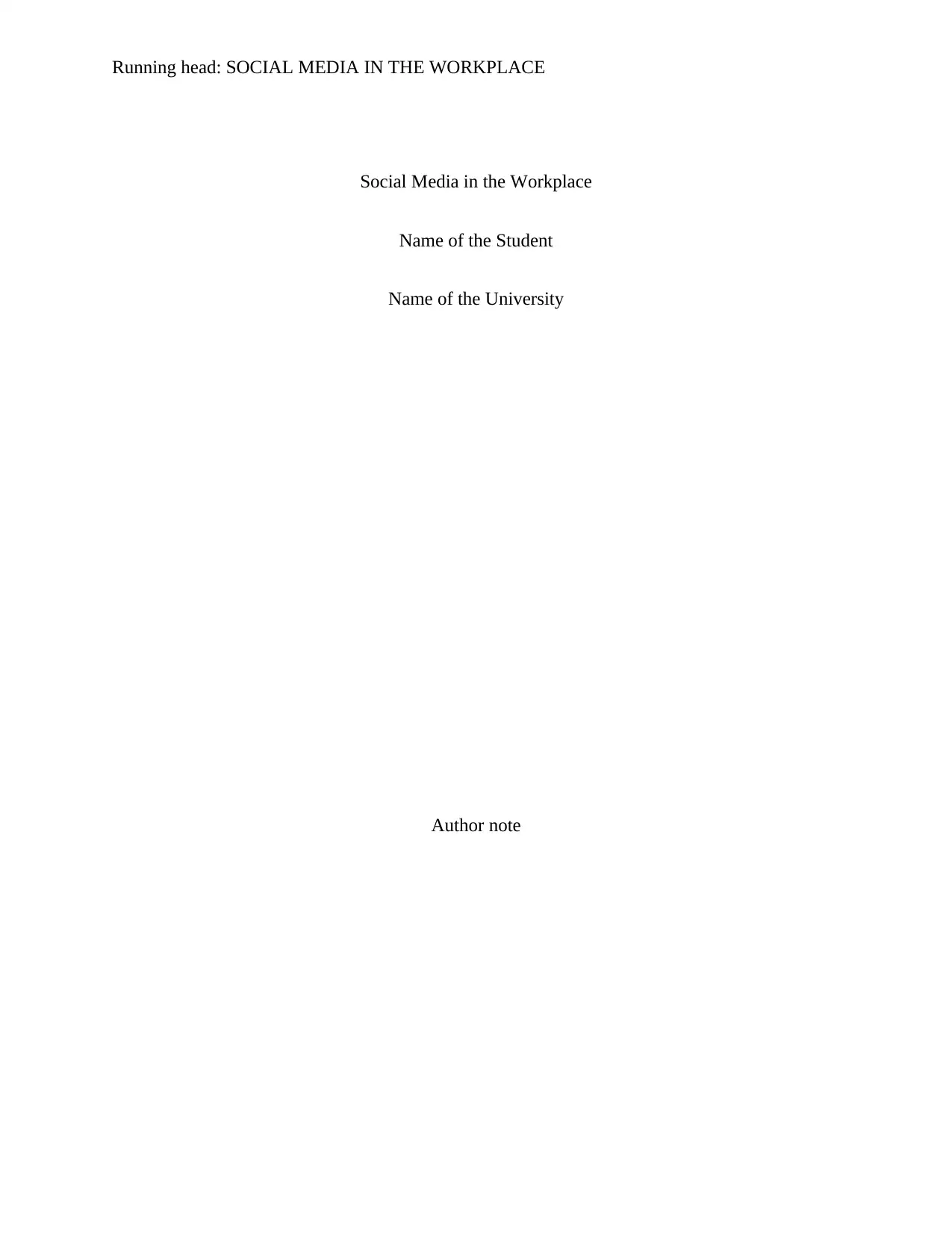
Running head: SOCIAL MEDIA IN THE WORKPLACE
Social Media in the Workplace
Name of the Student
Name of the University
Author note
Social Media in the Workplace
Name of the Student
Name of the University
Author note
Secure Best Marks with AI Grader
Need help grading? Try our AI Grader for instant feedback on your assignments.
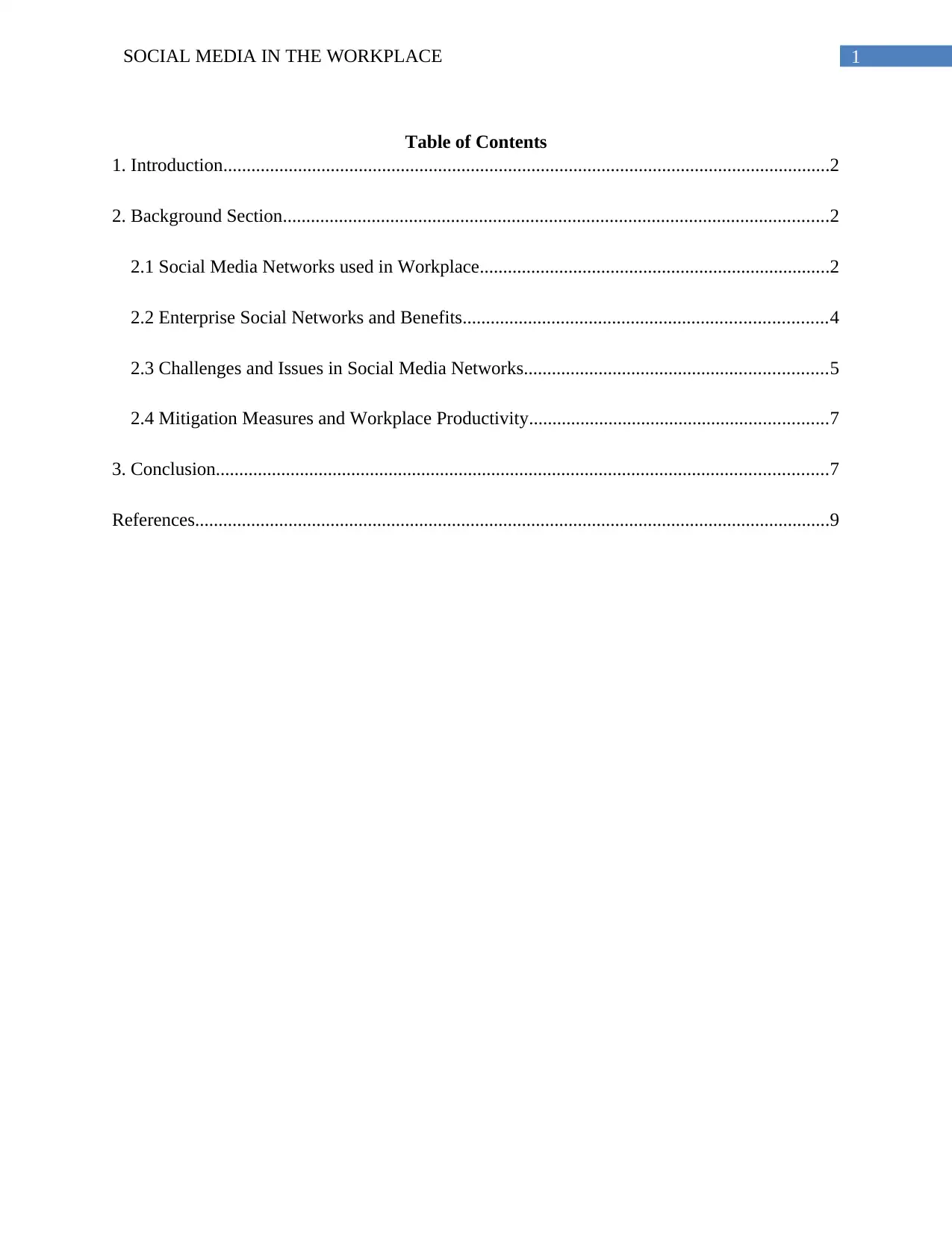
1SOCIAL MEDIA IN THE WORKPLACE
Table of Contents
1. Introduction..................................................................................................................................2
2. Background Section.....................................................................................................................2
2.1 Social Media Networks used in Workplace...........................................................................2
2.2 Enterprise Social Networks and Benefits..............................................................................4
2.3 Challenges and Issues in Social Media Networks.................................................................5
2.4 Mitigation Measures and Workplace Productivity................................................................7
3. Conclusion...................................................................................................................................7
References........................................................................................................................................9
Table of Contents
1. Introduction..................................................................................................................................2
2. Background Section.....................................................................................................................2
2.1 Social Media Networks used in Workplace...........................................................................2
2.2 Enterprise Social Networks and Benefits..............................................................................4
2.3 Challenges and Issues in Social Media Networks.................................................................5
2.4 Mitigation Measures and Workplace Productivity................................................................7
3. Conclusion...................................................................................................................................7
References........................................................................................................................................9
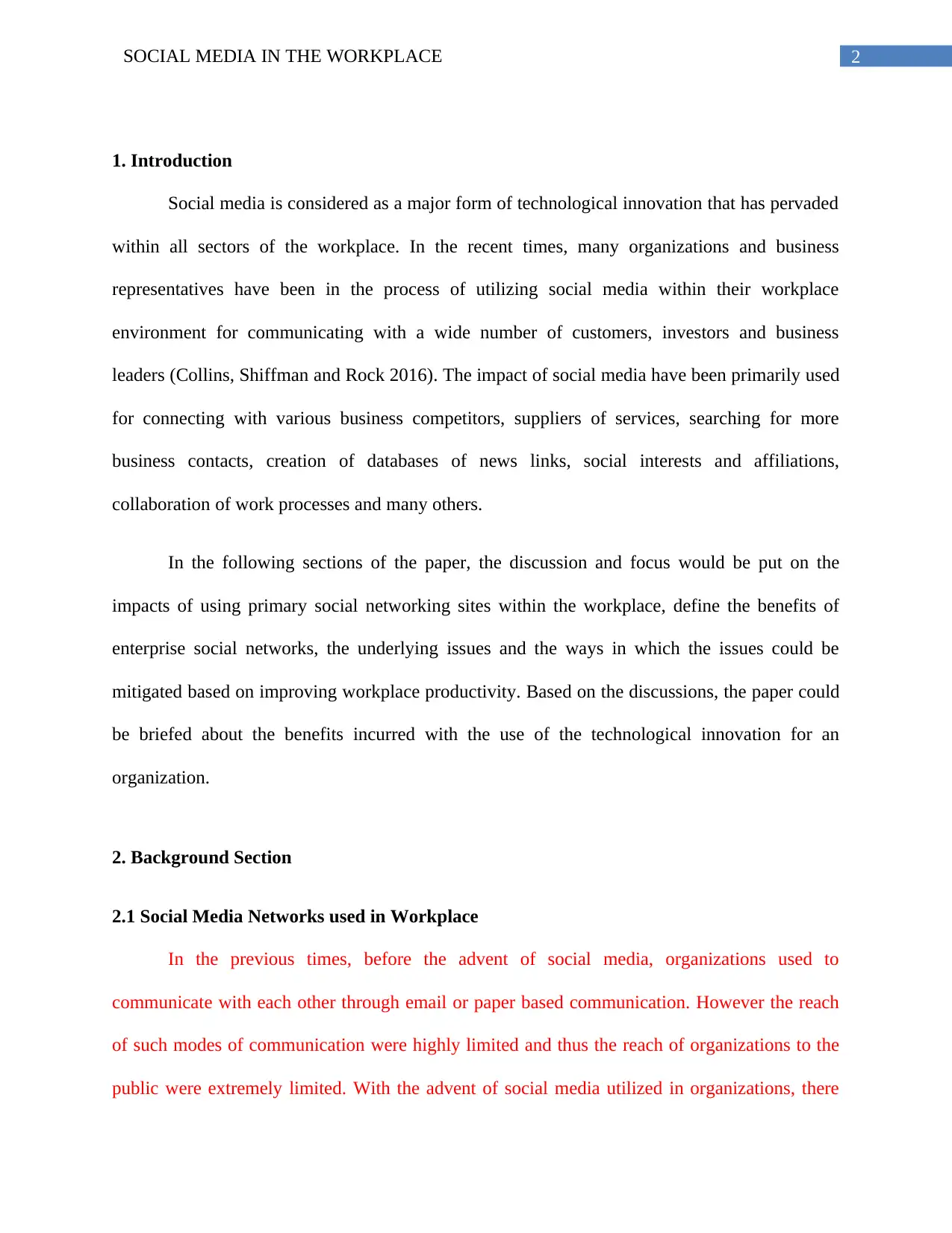
2SOCIAL MEDIA IN THE WORKPLACE
1. Introduction
Social media is considered as a major form of technological innovation that has pervaded
within all sectors of the workplace. In the recent times, many organizations and business
representatives have been in the process of utilizing social media within their workplace
environment for communicating with a wide number of customers, investors and business
leaders (Collins, Shiffman and Rock 2016). The impact of social media have been primarily used
for connecting with various business competitors, suppliers of services, searching for more
business contacts, creation of databases of news links, social interests and affiliations,
collaboration of work processes and many others.
In the following sections of the paper, the discussion and focus would be put on the
impacts of using primary social networking sites within the workplace, define the benefits of
enterprise social networks, the underlying issues and the ways in which the issues could be
mitigated based on improving workplace productivity. Based on the discussions, the paper could
be briefed about the benefits incurred with the use of the technological innovation for an
organization.
2. Background Section
2.1 Social Media Networks used in Workplace
In the previous times, before the advent of social media, organizations used to
communicate with each other through email or paper based communication. However the reach
of such modes of communication were highly limited and thus the reach of organizations to the
public were extremely limited. With the advent of social media utilized in organizations, there
1. Introduction
Social media is considered as a major form of technological innovation that has pervaded
within all sectors of the workplace. In the recent times, many organizations and business
representatives have been in the process of utilizing social media within their workplace
environment for communicating with a wide number of customers, investors and business
leaders (Collins, Shiffman and Rock 2016). The impact of social media have been primarily used
for connecting with various business competitors, suppliers of services, searching for more
business contacts, creation of databases of news links, social interests and affiliations,
collaboration of work processes and many others.
In the following sections of the paper, the discussion and focus would be put on the
impacts of using primary social networking sites within the workplace, define the benefits of
enterprise social networks, the underlying issues and the ways in which the issues could be
mitigated based on improving workplace productivity. Based on the discussions, the paper could
be briefed about the benefits incurred with the use of the technological innovation for an
organization.
2. Background Section
2.1 Social Media Networks used in Workplace
In the previous times, before the advent of social media, organizations used to
communicate with each other through email or paper based communication. However the reach
of such modes of communication were highly limited and thus the reach of organizations to the
public were extremely limited. With the advent of social media utilized in organizations, there
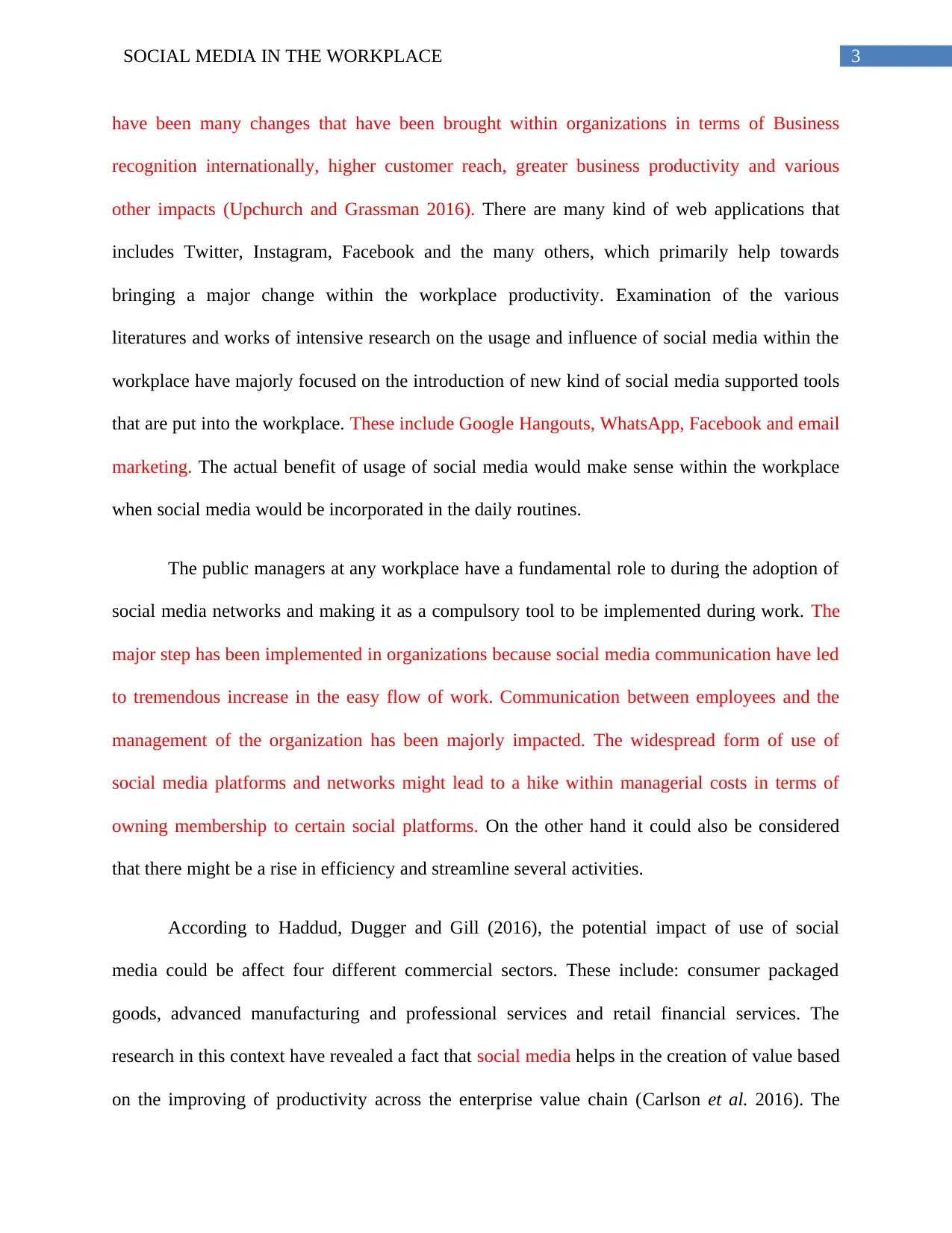
3SOCIAL MEDIA IN THE WORKPLACE
have been many changes that have been brought within organizations in terms of Business
recognition internationally, higher customer reach, greater business productivity and various
other impacts (Upchurch and Grassman 2016). There are many kind of web applications that
includes Twitter, Instagram, Facebook and the many others, which primarily help towards
bringing a major change within the workplace productivity. Examination of the various
literatures and works of intensive research on the usage and influence of social media within the
workplace have majorly focused on the introduction of new kind of social media supported tools
that are put into the workplace. These include Google Hangouts, WhatsApp, Facebook and email
marketing. The actual benefit of usage of social media would make sense within the workplace
when social media would be incorporated in the daily routines.
The public managers at any workplace have a fundamental role to during the adoption of
social media networks and making it as a compulsory tool to be implemented during work. The
major step has been implemented in organizations because social media communication have led
to tremendous increase in the easy flow of work. Communication between employees and the
management of the organization has been majorly impacted. The widespread form of use of
social media platforms and networks might lead to a hike within managerial costs in terms of
owning membership to certain social platforms. On the other hand it could also be considered
that there might be a rise in efficiency and streamline several activities.
According to Haddud, Dugger and Gill (2016), the potential impact of use of social
media could be affect four different commercial sectors. These include: consumer packaged
goods, advanced manufacturing and professional services and retail financial services. The
research in this context have revealed a fact that social media helps in the creation of value based
on the improving of productivity across the enterprise value chain (Carlson et al. 2016). The
have been many changes that have been brought within organizations in terms of Business
recognition internationally, higher customer reach, greater business productivity and various
other impacts (Upchurch and Grassman 2016). There are many kind of web applications that
includes Twitter, Instagram, Facebook and the many others, which primarily help towards
bringing a major change within the workplace productivity. Examination of the various
literatures and works of intensive research on the usage and influence of social media within the
workplace have majorly focused on the introduction of new kind of social media supported tools
that are put into the workplace. These include Google Hangouts, WhatsApp, Facebook and email
marketing. The actual benefit of usage of social media would make sense within the workplace
when social media would be incorporated in the daily routines.
The public managers at any workplace have a fundamental role to during the adoption of
social media networks and making it as a compulsory tool to be implemented during work. The
major step has been implemented in organizations because social media communication have led
to tremendous increase in the easy flow of work. Communication between employees and the
management of the organization has been majorly impacted. The widespread form of use of
social media platforms and networks might lead to a hike within managerial costs in terms of
owning membership to certain social platforms. On the other hand it could also be considered
that there might be a rise in efficiency and streamline several activities.
According to Haddud, Dugger and Gill (2016), the potential impact of use of social
media could be affect four different commercial sectors. These include: consumer packaged
goods, advanced manufacturing and professional services and retail financial services. The
research in this context have revealed a fact that social media helps in the creation of value based
on the improving of productivity across the enterprise value chain (Carlson et al. 2016). The
Secure Best Marks with AI Grader
Need help grading? Try our AI Grader for instant feedback on your assignments.
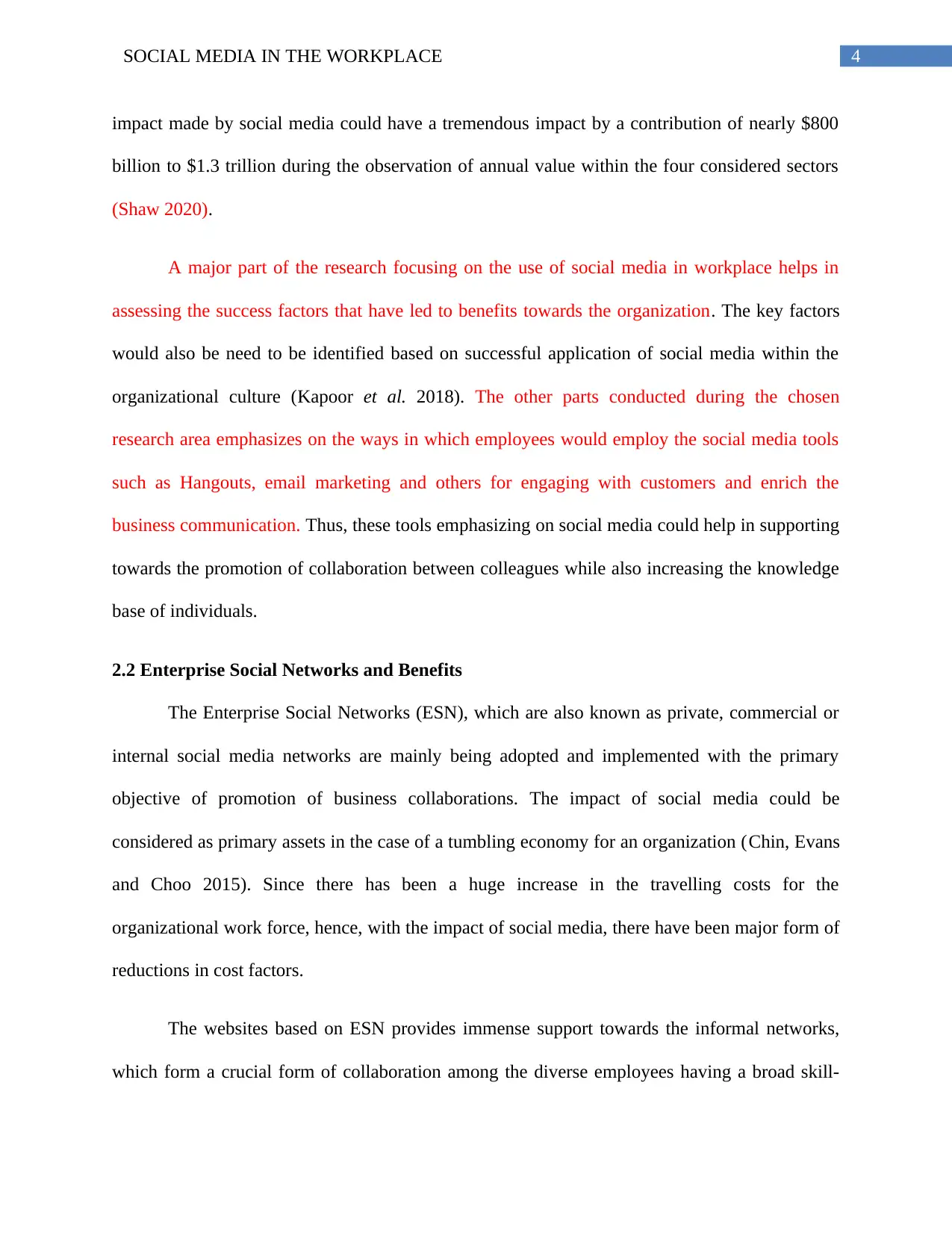
4SOCIAL MEDIA IN THE WORKPLACE
impact made by social media could have a tremendous impact by a contribution of nearly $800
billion to $1.3 trillion during the observation of annual value within the four considered sectors
(Shaw 2020).
A major part of the research focusing on the use of social media in workplace helps in
assessing the success factors that have led to benefits towards the organization. The key factors
would also be need to be identified based on successful application of social media within the
organizational culture (Kapoor et al. 2018). The other parts conducted during the chosen
research area emphasizes on the ways in which employees would employ the social media tools
such as Hangouts, email marketing and others for engaging with customers and enrich the
business communication. Thus, these tools emphasizing on social media could help in supporting
towards the promotion of collaboration between colleagues while also increasing the knowledge
base of individuals.
2.2 Enterprise Social Networks and Benefits
The Enterprise Social Networks (ESN), which are also known as private, commercial or
internal social media networks are mainly being adopted and implemented with the primary
objective of promotion of business collaborations. The impact of social media could be
considered as primary assets in the case of a tumbling economy for an organization (Chin, Evans
and Choo 2015). Since there has been a huge increase in the travelling costs for the
organizational work force, hence, with the impact of social media, there have been major form of
reductions in cost factors.
The websites based on ESN provides immense support towards the informal networks,
which form a crucial form of collaboration among the diverse employees having a broad skill-
impact made by social media could have a tremendous impact by a contribution of nearly $800
billion to $1.3 trillion during the observation of annual value within the four considered sectors
(Shaw 2020).
A major part of the research focusing on the use of social media in workplace helps in
assessing the success factors that have led to benefits towards the organization. The key factors
would also be need to be identified based on successful application of social media within the
organizational culture (Kapoor et al. 2018). The other parts conducted during the chosen
research area emphasizes on the ways in which employees would employ the social media tools
such as Hangouts, email marketing and others for engaging with customers and enrich the
business communication. Thus, these tools emphasizing on social media could help in supporting
towards the promotion of collaboration between colleagues while also increasing the knowledge
base of individuals.
2.2 Enterprise Social Networks and Benefits
The Enterprise Social Networks (ESN), which are also known as private, commercial or
internal social media networks are mainly being adopted and implemented with the primary
objective of promotion of business collaborations. The impact of social media could be
considered as primary assets in the case of a tumbling economy for an organization (Chin, Evans
and Choo 2015). Since there has been a huge increase in the travelling costs for the
organizational work force, hence, with the impact of social media, there have been major form of
reductions in cost factors.
The websites based on ESN provides immense support towards the informal networks,
which form a crucial form of collaboration among the diverse employees having a broad skill-
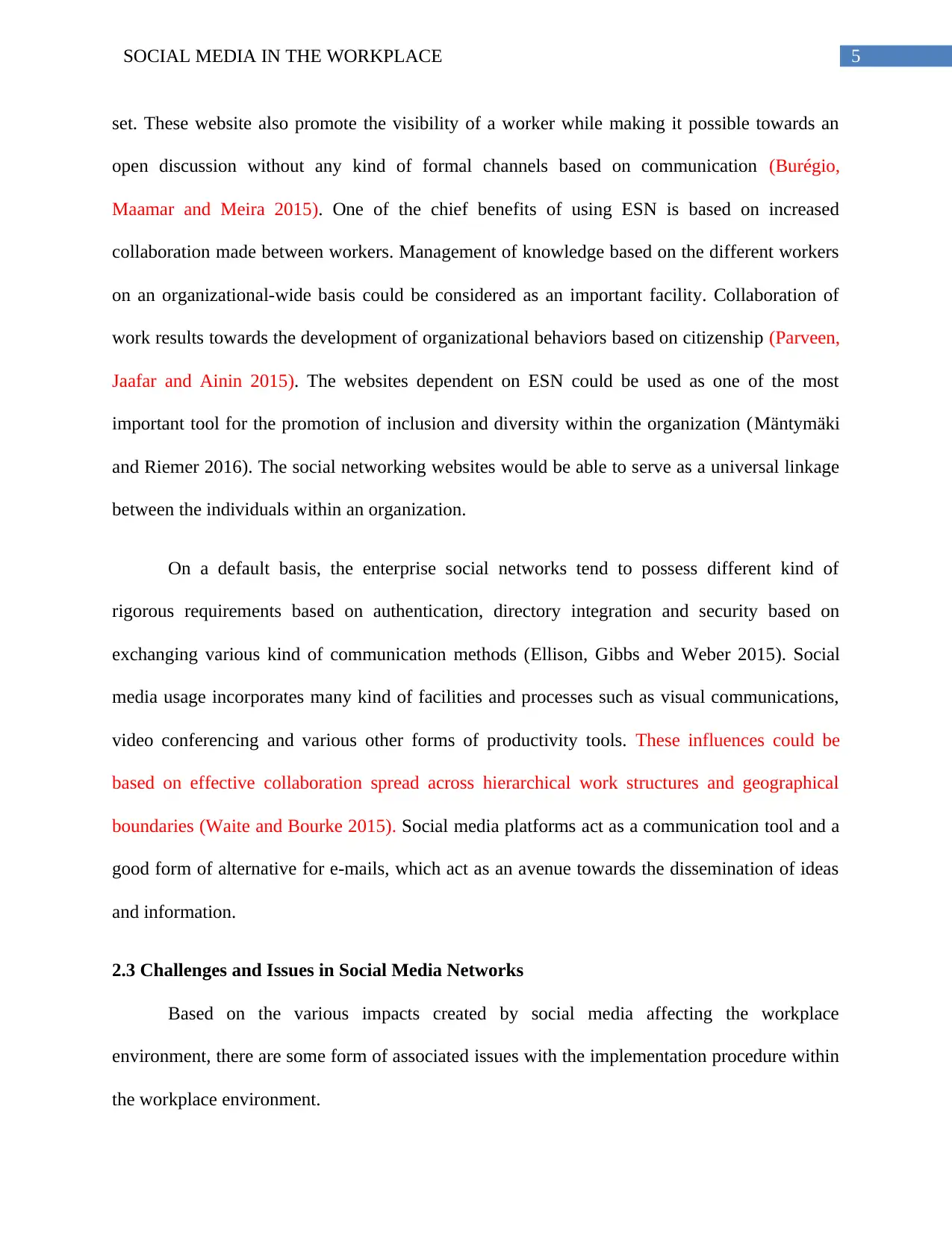
5SOCIAL MEDIA IN THE WORKPLACE
set. These website also promote the visibility of a worker while making it possible towards an
open discussion without any kind of formal channels based on communication (Burégio,
Maamar and Meira 2015). One of the chief benefits of using ESN is based on increased
collaboration made between workers. Management of knowledge based on the different workers
on an organizational-wide basis could be considered as an important facility. Collaboration of
work results towards the development of organizational behaviors based on citizenship (Parveen,
Jaafar and Ainin 2015). The websites dependent on ESN could be used as one of the most
important tool for the promotion of inclusion and diversity within the organization (Mäntymäki
and Riemer 2016). The social networking websites would be able to serve as a universal linkage
between the individuals within an organization.
On a default basis, the enterprise social networks tend to possess different kind of
rigorous requirements based on authentication, directory integration and security based on
exchanging various kind of communication methods (Ellison, Gibbs and Weber 2015). Social
media usage incorporates many kind of facilities and processes such as visual communications,
video conferencing and various other forms of productivity tools. These influences could be
based on effective collaboration spread across hierarchical work structures and geographical
boundaries (Waite and Bourke 2015). Social media platforms act as a communication tool and a
good form of alternative for e-mails, which act as an avenue towards the dissemination of ideas
and information.
2.3 Challenges and Issues in Social Media Networks
Based on the various impacts created by social media affecting the workplace
environment, there are some form of associated issues with the implementation procedure within
the workplace environment.
set. These website also promote the visibility of a worker while making it possible towards an
open discussion without any kind of formal channels based on communication (Burégio,
Maamar and Meira 2015). One of the chief benefits of using ESN is based on increased
collaboration made between workers. Management of knowledge based on the different workers
on an organizational-wide basis could be considered as an important facility. Collaboration of
work results towards the development of organizational behaviors based on citizenship (Parveen,
Jaafar and Ainin 2015). The websites dependent on ESN could be used as one of the most
important tool for the promotion of inclusion and diversity within the organization (Mäntymäki
and Riemer 2016). The social networking websites would be able to serve as a universal linkage
between the individuals within an organization.
On a default basis, the enterprise social networks tend to possess different kind of
rigorous requirements based on authentication, directory integration and security based on
exchanging various kind of communication methods (Ellison, Gibbs and Weber 2015). Social
media usage incorporates many kind of facilities and processes such as visual communications,
video conferencing and various other forms of productivity tools. These influences could be
based on effective collaboration spread across hierarchical work structures and geographical
boundaries (Waite and Bourke 2015). Social media platforms act as a communication tool and a
good form of alternative for e-mails, which act as an avenue towards the dissemination of ideas
and information.
2.3 Challenges and Issues in Social Media Networks
Based on the various impacts created by social media affecting the workplace
environment, there are some form of associated issues with the implementation procedure within
the workplace environment.
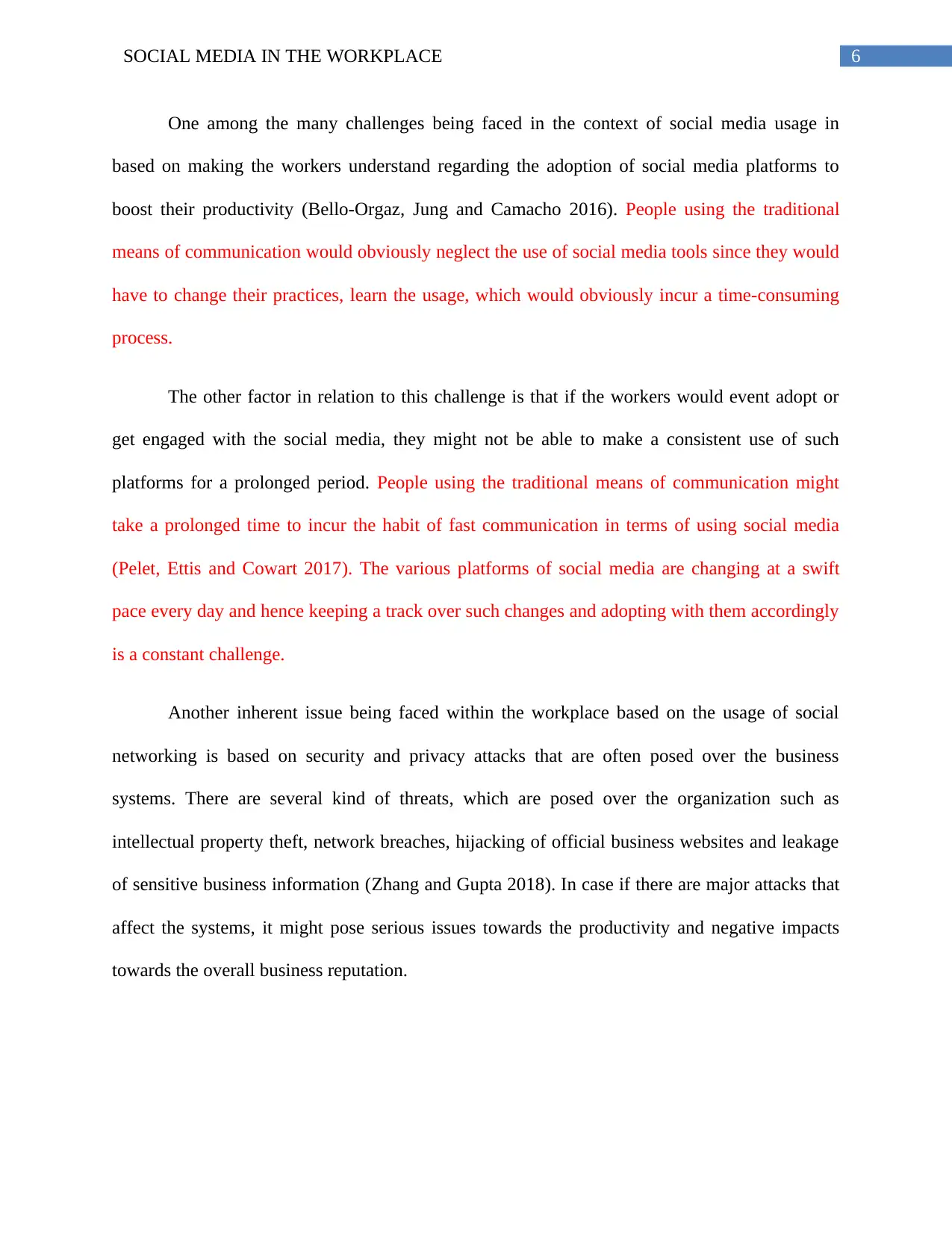
6SOCIAL MEDIA IN THE WORKPLACE
One among the many challenges being faced in the context of social media usage in
based on making the workers understand regarding the adoption of social media platforms to
boost their productivity (Bello-Orgaz, Jung and Camacho 2016). People using the traditional
means of communication would obviously neglect the use of social media tools since they would
have to change their practices, learn the usage, which would obviously incur a time-consuming
process.
The other factor in relation to this challenge is that if the workers would event adopt or
get engaged with the social media, they might not be able to make a consistent use of such
platforms for a prolonged period. People using the traditional means of communication might
take a prolonged time to incur the habit of fast communication in terms of using social media
(Pelet, Ettis and Cowart 2017). The various platforms of social media are changing at a swift
pace every day and hence keeping a track over such changes and adopting with them accordingly
is a constant challenge.
Another inherent issue being faced within the workplace based on the usage of social
networking is based on security and privacy attacks that are often posed over the business
systems. There are several kind of threats, which are posed over the organization such as
intellectual property theft, network breaches, hijacking of official business websites and leakage
of sensitive business information (Zhang and Gupta 2018). In case if there are major attacks that
affect the systems, it might pose serious issues towards the productivity and negative impacts
towards the overall business reputation.
One among the many challenges being faced in the context of social media usage in
based on making the workers understand regarding the adoption of social media platforms to
boost their productivity (Bello-Orgaz, Jung and Camacho 2016). People using the traditional
means of communication would obviously neglect the use of social media tools since they would
have to change their practices, learn the usage, which would obviously incur a time-consuming
process.
The other factor in relation to this challenge is that if the workers would event adopt or
get engaged with the social media, they might not be able to make a consistent use of such
platforms for a prolonged period. People using the traditional means of communication might
take a prolonged time to incur the habit of fast communication in terms of using social media
(Pelet, Ettis and Cowart 2017). The various platforms of social media are changing at a swift
pace every day and hence keeping a track over such changes and adopting with them accordingly
is a constant challenge.
Another inherent issue being faced within the workplace based on the usage of social
networking is based on security and privacy attacks that are often posed over the business
systems. There are several kind of threats, which are posed over the organization such as
intellectual property theft, network breaches, hijacking of official business websites and leakage
of sensitive business information (Zhang and Gupta 2018). In case if there are major attacks that
affect the systems, it might pose serious issues towards the productivity and negative impacts
towards the overall business reputation.
Paraphrase This Document
Need a fresh take? Get an instant paraphrase of this document with our AI Paraphraser
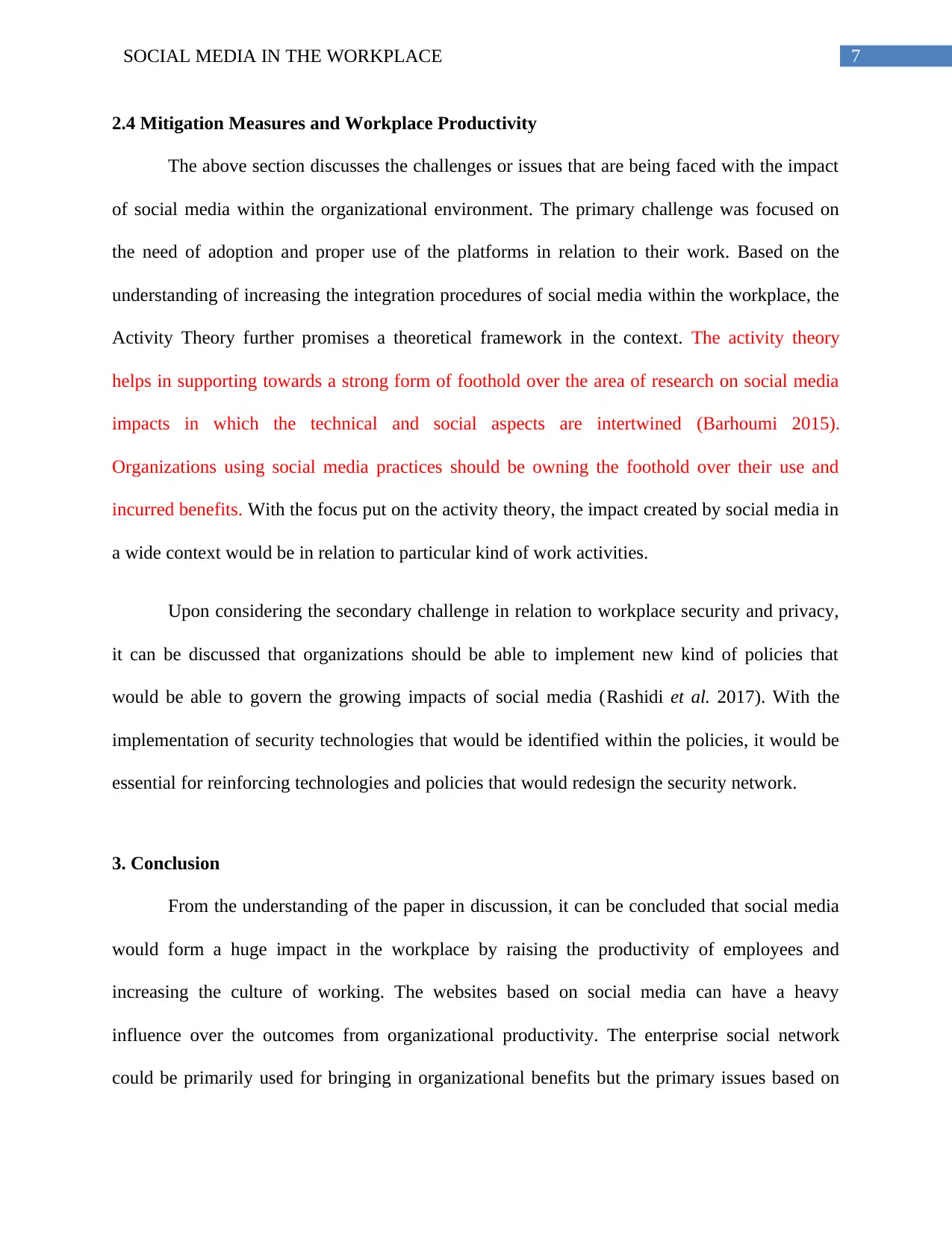
7SOCIAL MEDIA IN THE WORKPLACE
2.4 Mitigation Measures and Workplace Productivity
The above section discusses the challenges or issues that are being faced with the impact
of social media within the organizational environment. The primary challenge was focused on
the need of adoption and proper use of the platforms in relation to their work. Based on the
understanding of increasing the integration procedures of social media within the workplace, the
Activity Theory further promises a theoretical framework in the context. The activity theory
helps in supporting towards a strong form of foothold over the area of research on social media
impacts in which the technical and social aspects are intertwined (Barhoumi 2015).
Organizations using social media practices should be owning the foothold over their use and
incurred benefits. With the focus put on the activity theory, the impact created by social media in
a wide context would be in relation to particular kind of work activities.
Upon considering the secondary challenge in relation to workplace security and privacy,
it can be discussed that organizations should be able to implement new kind of policies that
would be able to govern the growing impacts of social media (Rashidi et al. 2017). With the
implementation of security technologies that would be identified within the policies, it would be
essential for reinforcing technologies and policies that would redesign the security network.
3. Conclusion
From the understanding of the paper in discussion, it can be concluded that social media
would form a huge impact in the workplace by raising the productivity of employees and
increasing the culture of working. The websites based on social media can have a heavy
influence over the outcomes from organizational productivity. The enterprise social network
could be primarily used for bringing in organizational benefits but the primary issues based on
2.4 Mitigation Measures and Workplace Productivity
The above section discusses the challenges or issues that are being faced with the impact
of social media within the organizational environment. The primary challenge was focused on
the need of adoption and proper use of the platforms in relation to their work. Based on the
understanding of increasing the integration procedures of social media within the workplace, the
Activity Theory further promises a theoretical framework in the context. The activity theory
helps in supporting towards a strong form of foothold over the area of research on social media
impacts in which the technical and social aspects are intertwined (Barhoumi 2015).
Organizations using social media practices should be owning the foothold over their use and
incurred benefits. With the focus put on the activity theory, the impact created by social media in
a wide context would be in relation to particular kind of work activities.
Upon considering the secondary challenge in relation to workplace security and privacy,
it can be discussed that organizations should be able to implement new kind of policies that
would be able to govern the growing impacts of social media (Rashidi et al. 2017). With the
implementation of security technologies that would be identified within the policies, it would be
essential for reinforcing technologies and policies that would redesign the security network.
3. Conclusion
From the understanding of the paper in discussion, it can be concluded that social media
would form a huge impact in the workplace by raising the productivity of employees and
increasing the culture of working. The websites based on social media can have a heavy
influence over the outcomes from organizational productivity. The enterprise social network
could be primarily used for bringing in organizational benefits but the primary issues based on
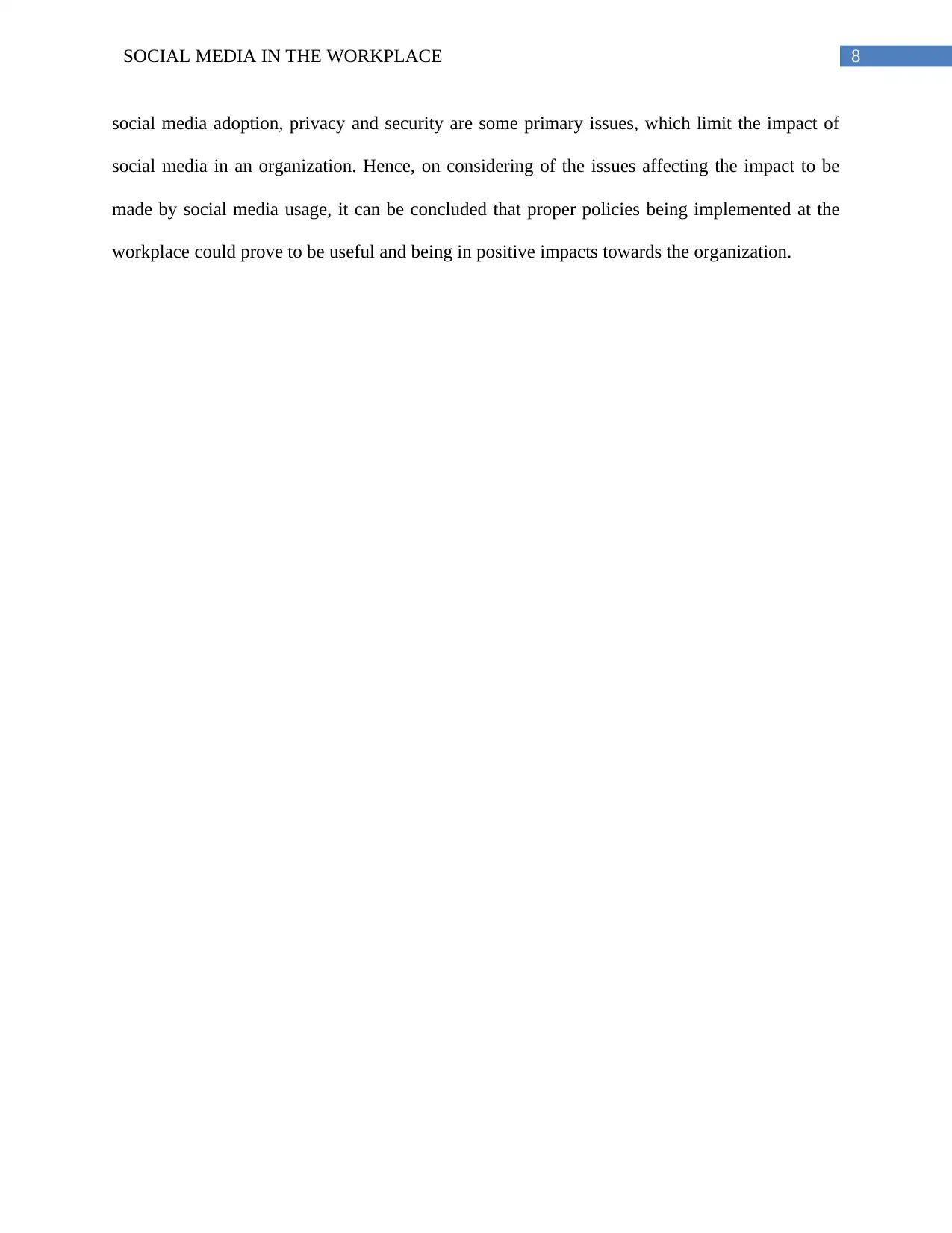
8SOCIAL MEDIA IN THE WORKPLACE
social media adoption, privacy and security are some primary issues, which limit the impact of
social media in an organization. Hence, on considering of the issues affecting the impact to be
made by social media usage, it can be concluded that proper policies being implemented at the
workplace could prove to be useful and being in positive impacts towards the organization.
social media adoption, privacy and security are some primary issues, which limit the impact of
social media in an organization. Hence, on considering of the issues affecting the impact to be
made by social media usage, it can be concluded that proper policies being implemented at the
workplace could prove to be useful and being in positive impacts towards the organization.
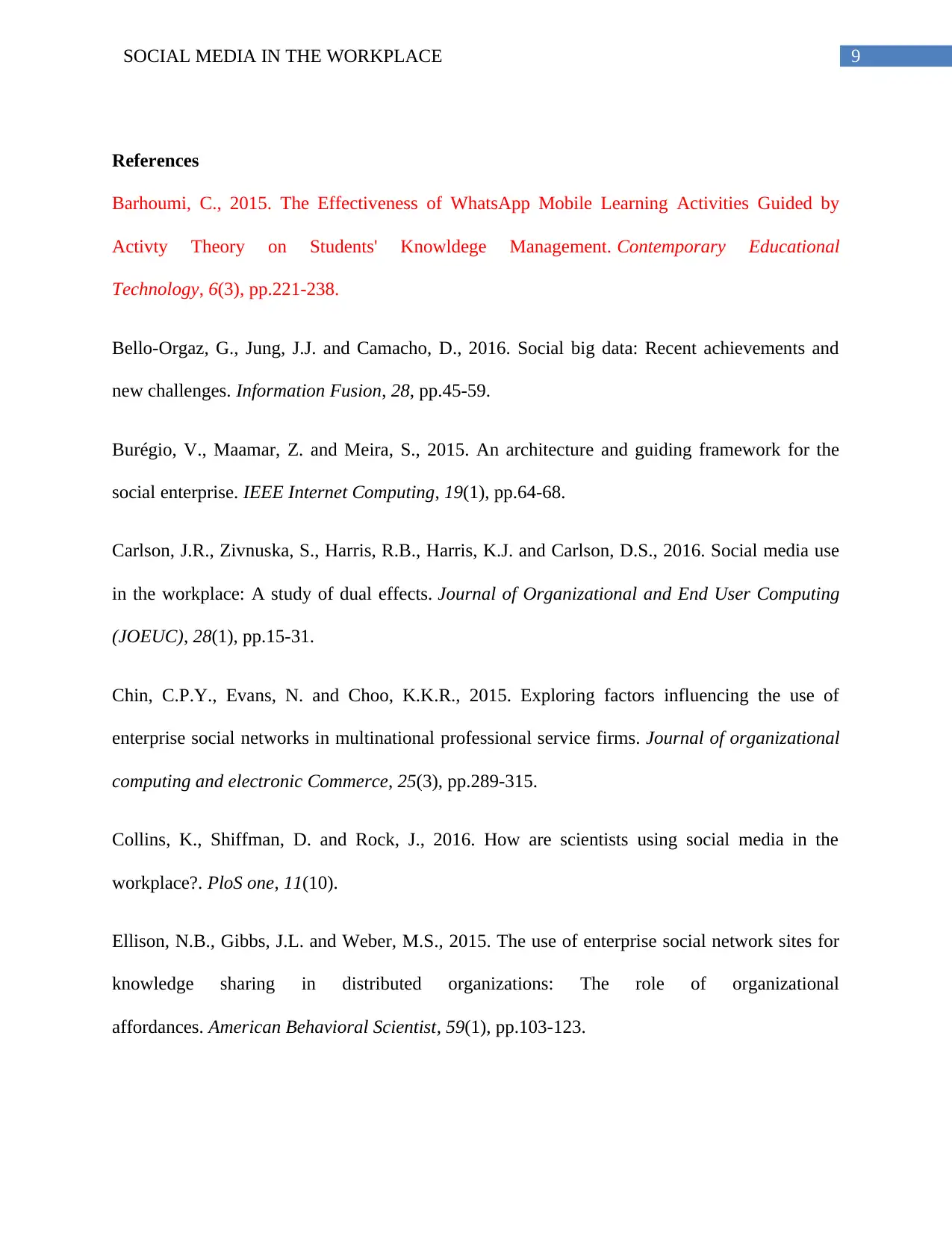
9SOCIAL MEDIA IN THE WORKPLACE
References
Barhoumi, C., 2015. The Effectiveness of WhatsApp Mobile Learning Activities Guided by
Activty Theory on Students' Knowldege Management. Contemporary Educational
Technology, 6(3), pp.221-238.
Bello-Orgaz, G., Jung, J.J. and Camacho, D., 2016. Social big data: Recent achievements and
new challenges. Information Fusion, 28, pp.45-59.
Burégio, V., Maamar, Z. and Meira, S., 2015. An architecture and guiding framework for the
social enterprise. IEEE Internet Computing, 19(1), pp.64-68.
Carlson, J.R., Zivnuska, S., Harris, R.B., Harris, K.J. and Carlson, D.S., 2016. Social media use
in the workplace: A study of dual effects. Journal of Organizational and End User Computing
(JOEUC), 28(1), pp.15-31.
Chin, C.P.Y., Evans, N. and Choo, K.K.R., 2015. Exploring factors influencing the use of
enterprise social networks in multinational professional service firms. Journal of organizational
computing and electronic Commerce, 25(3), pp.289-315.
Collins, K., Shiffman, D. and Rock, J., 2016. How are scientists using social media in the
workplace?. PloS one, 11(10).
Ellison, N.B., Gibbs, J.L. and Weber, M.S., 2015. The use of enterprise social network sites for
knowledge sharing in distributed organizations: The role of organizational
affordances. American Behavioral Scientist, 59(1), pp.103-123.
References
Barhoumi, C., 2015. The Effectiveness of WhatsApp Mobile Learning Activities Guided by
Activty Theory on Students' Knowldege Management. Contemporary Educational
Technology, 6(3), pp.221-238.
Bello-Orgaz, G., Jung, J.J. and Camacho, D., 2016. Social big data: Recent achievements and
new challenges. Information Fusion, 28, pp.45-59.
Burégio, V., Maamar, Z. and Meira, S., 2015. An architecture and guiding framework for the
social enterprise. IEEE Internet Computing, 19(1), pp.64-68.
Carlson, J.R., Zivnuska, S., Harris, R.B., Harris, K.J. and Carlson, D.S., 2016. Social media use
in the workplace: A study of dual effects. Journal of Organizational and End User Computing
(JOEUC), 28(1), pp.15-31.
Chin, C.P.Y., Evans, N. and Choo, K.K.R., 2015. Exploring factors influencing the use of
enterprise social networks in multinational professional service firms. Journal of organizational
computing and electronic Commerce, 25(3), pp.289-315.
Collins, K., Shiffman, D. and Rock, J., 2016. How are scientists using social media in the
workplace?. PloS one, 11(10).
Ellison, N.B., Gibbs, J.L. and Weber, M.S., 2015. The use of enterprise social network sites for
knowledge sharing in distributed organizations: The role of organizational
affordances. American Behavioral Scientist, 59(1), pp.103-123.
Secure Best Marks with AI Grader
Need help grading? Try our AI Grader for instant feedback on your assignments.
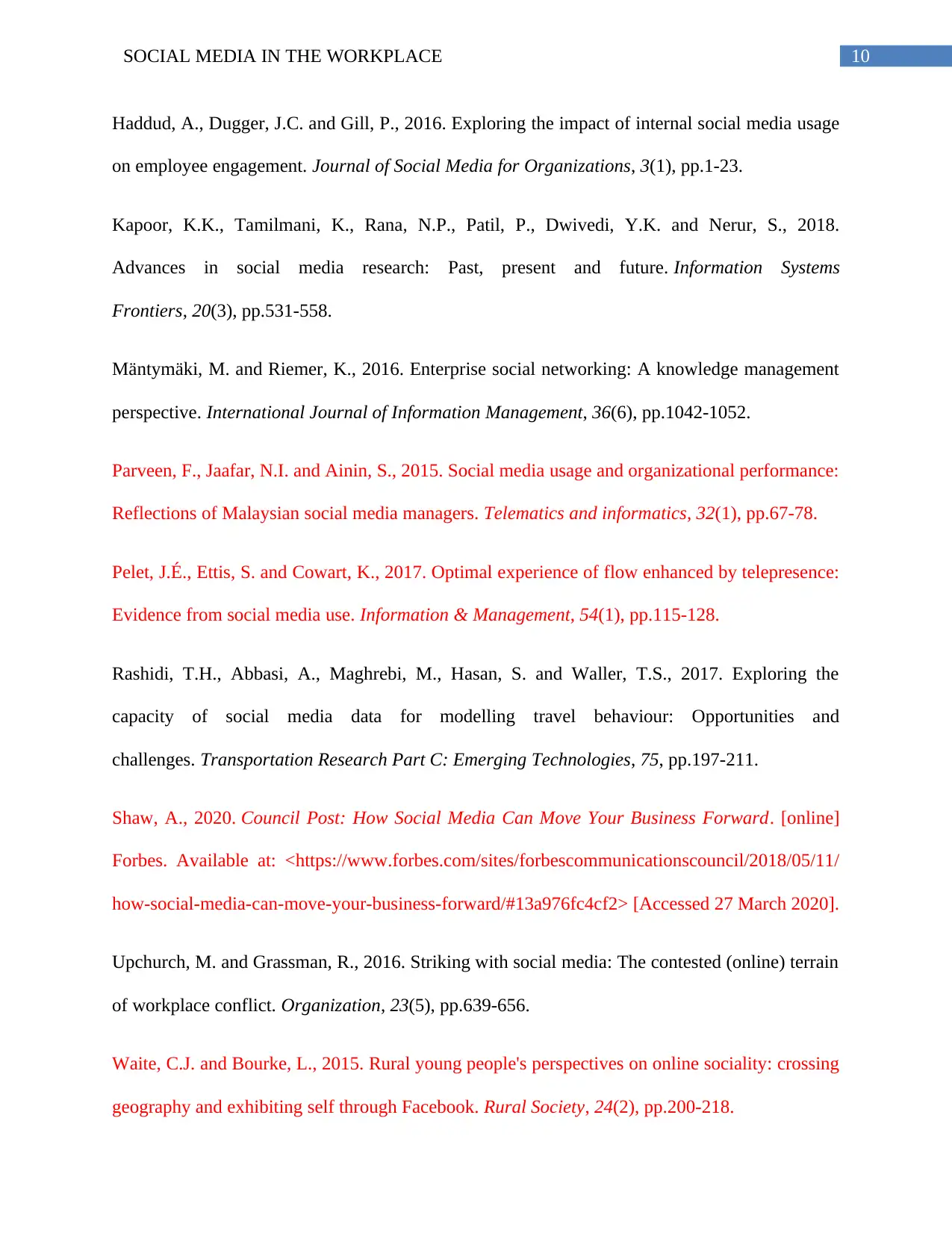
10SOCIAL MEDIA IN THE WORKPLACE
Haddud, A., Dugger, J.C. and Gill, P., 2016. Exploring the impact of internal social media usage
on employee engagement. Journal of Social Media for Organizations, 3(1), pp.1-23.
Kapoor, K.K., Tamilmani, K., Rana, N.P., Patil, P., Dwivedi, Y.K. and Nerur, S., 2018.
Advances in social media research: Past, present and future. Information Systems
Frontiers, 20(3), pp.531-558.
Mäntymäki, M. and Riemer, K., 2016. Enterprise social networking: A knowledge management
perspective. International Journal of Information Management, 36(6), pp.1042-1052.
Parveen, F., Jaafar, N.I. and Ainin, S., 2015. Social media usage and organizational performance:
Reflections of Malaysian social media managers. Telematics and informatics, 32(1), pp.67-78.
Pelet, J.É., Ettis, S. and Cowart, K., 2017. Optimal experience of flow enhanced by telepresence:
Evidence from social media use. Information & Management, 54(1), pp.115-128.
Rashidi, T.H., Abbasi, A., Maghrebi, M., Hasan, S. and Waller, T.S., 2017. Exploring the
capacity of social media data for modelling travel behaviour: Opportunities and
challenges. Transportation Research Part C: Emerging Technologies, 75, pp.197-211.
Shaw, A., 2020. Council Post: How Social Media Can Move Your Business Forward. [online]
Forbes. Available at: <https://www.forbes.com/sites/forbescommunicationscouncil/2018/05/11/
how-social-media-can-move-your-business-forward/#13a976fc4cf2> [Accessed 27 March 2020].
Upchurch, M. and Grassman, R., 2016. Striking with social media: The contested (online) terrain
of workplace conflict. Organization, 23(5), pp.639-656.
Waite, C.J. and Bourke, L., 2015. Rural young people's perspectives on online sociality: crossing
geography and exhibiting self through Facebook. Rural Society, 24(2), pp.200-218.
Haddud, A., Dugger, J.C. and Gill, P., 2016. Exploring the impact of internal social media usage
on employee engagement. Journal of Social Media for Organizations, 3(1), pp.1-23.
Kapoor, K.K., Tamilmani, K., Rana, N.P., Patil, P., Dwivedi, Y.K. and Nerur, S., 2018.
Advances in social media research: Past, present and future. Information Systems
Frontiers, 20(3), pp.531-558.
Mäntymäki, M. and Riemer, K., 2016. Enterprise social networking: A knowledge management
perspective. International Journal of Information Management, 36(6), pp.1042-1052.
Parveen, F., Jaafar, N.I. and Ainin, S., 2015. Social media usage and organizational performance:
Reflections of Malaysian social media managers. Telematics and informatics, 32(1), pp.67-78.
Pelet, J.É., Ettis, S. and Cowart, K., 2017. Optimal experience of flow enhanced by telepresence:
Evidence from social media use. Information & Management, 54(1), pp.115-128.
Rashidi, T.H., Abbasi, A., Maghrebi, M., Hasan, S. and Waller, T.S., 2017. Exploring the
capacity of social media data for modelling travel behaviour: Opportunities and
challenges. Transportation Research Part C: Emerging Technologies, 75, pp.197-211.
Shaw, A., 2020. Council Post: How Social Media Can Move Your Business Forward. [online]
Forbes. Available at: <https://www.forbes.com/sites/forbescommunicationscouncil/2018/05/11/
how-social-media-can-move-your-business-forward/#13a976fc4cf2> [Accessed 27 March 2020].
Upchurch, M. and Grassman, R., 2016. Striking with social media: The contested (online) terrain
of workplace conflict. Organization, 23(5), pp.639-656.
Waite, C.J. and Bourke, L., 2015. Rural young people's perspectives on online sociality: crossing
geography and exhibiting self through Facebook. Rural Society, 24(2), pp.200-218.
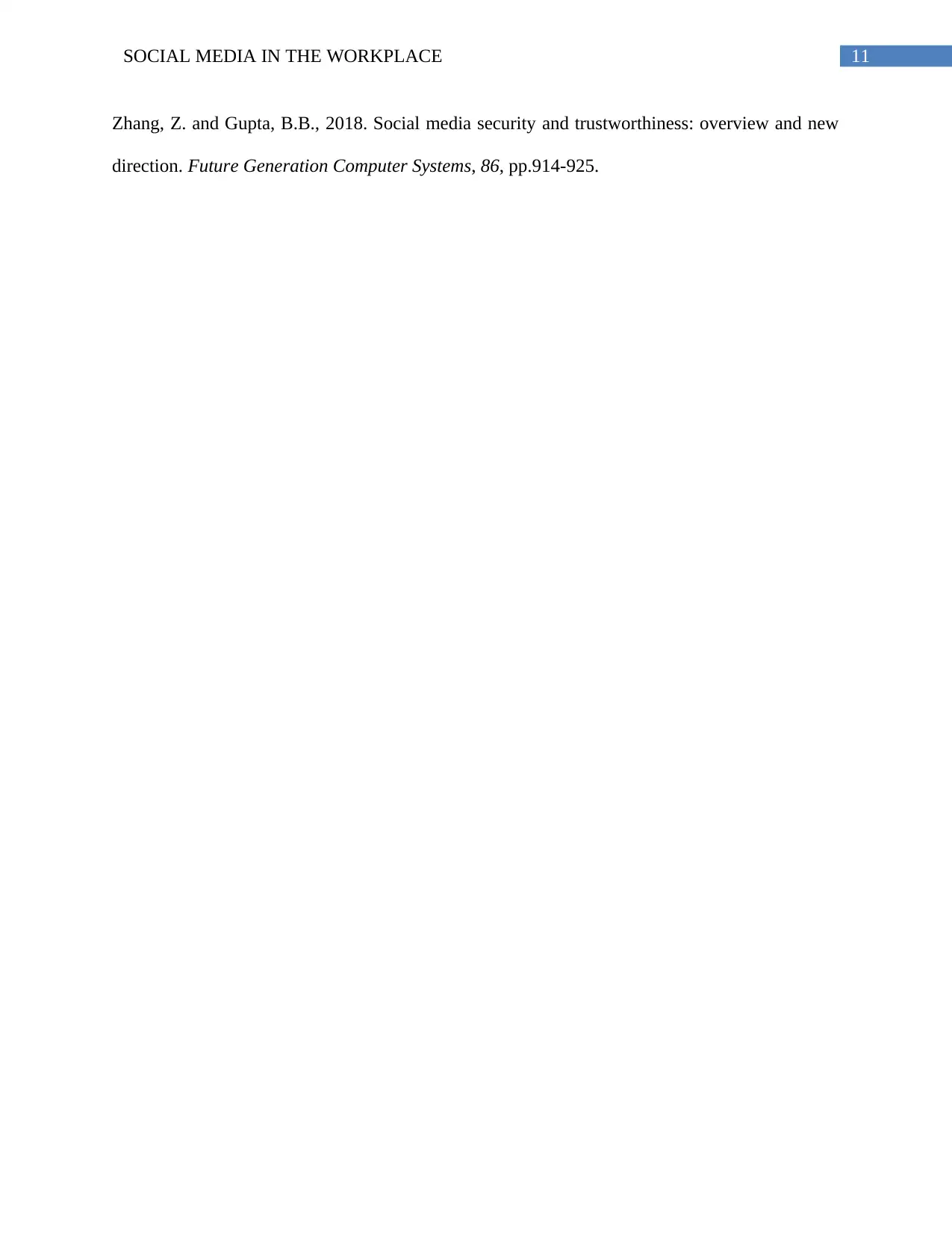
11SOCIAL MEDIA IN THE WORKPLACE
Zhang, Z. and Gupta, B.B., 2018. Social media security and trustworthiness: overview and new
direction. Future Generation Computer Systems, 86, pp.914-925.
Zhang, Z. and Gupta, B.B., 2018. Social media security and trustworthiness: overview and new
direction. Future Generation Computer Systems, 86, pp.914-925.
1 out of 12
Related Documents
Your All-in-One AI-Powered Toolkit for Academic Success.
+13062052269
info@desklib.com
Available 24*7 on WhatsApp / Email
![[object Object]](/_next/static/media/star-bottom.7253800d.svg)
Unlock your academic potential
© 2024 | Zucol Services PVT LTD | All rights reserved.




